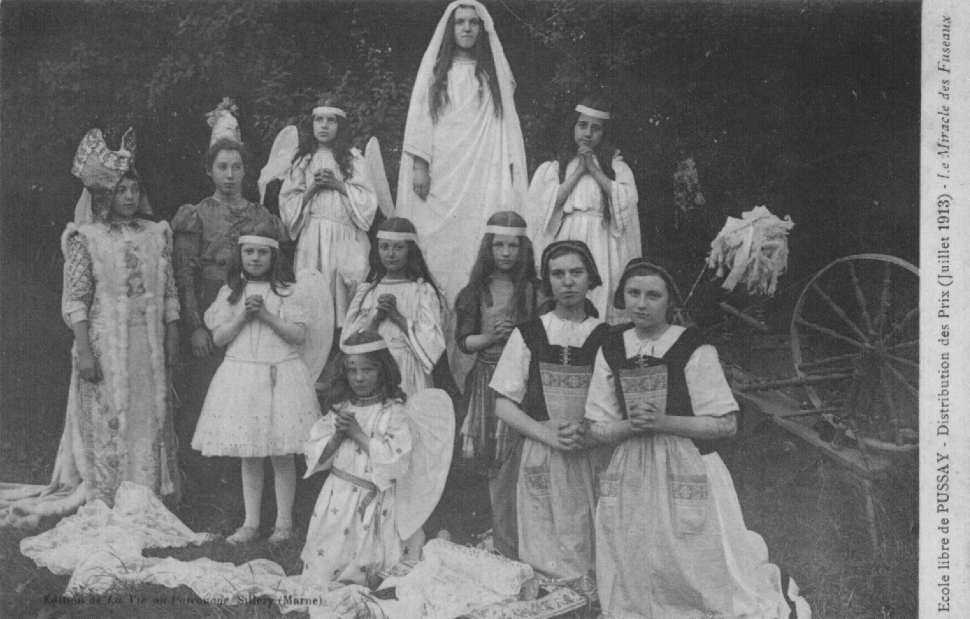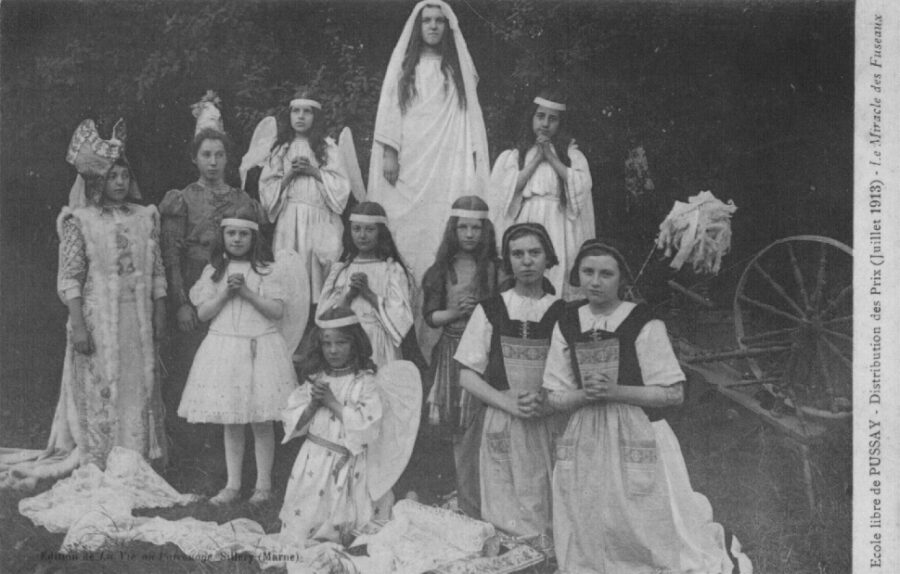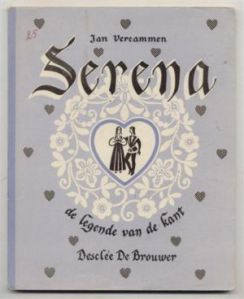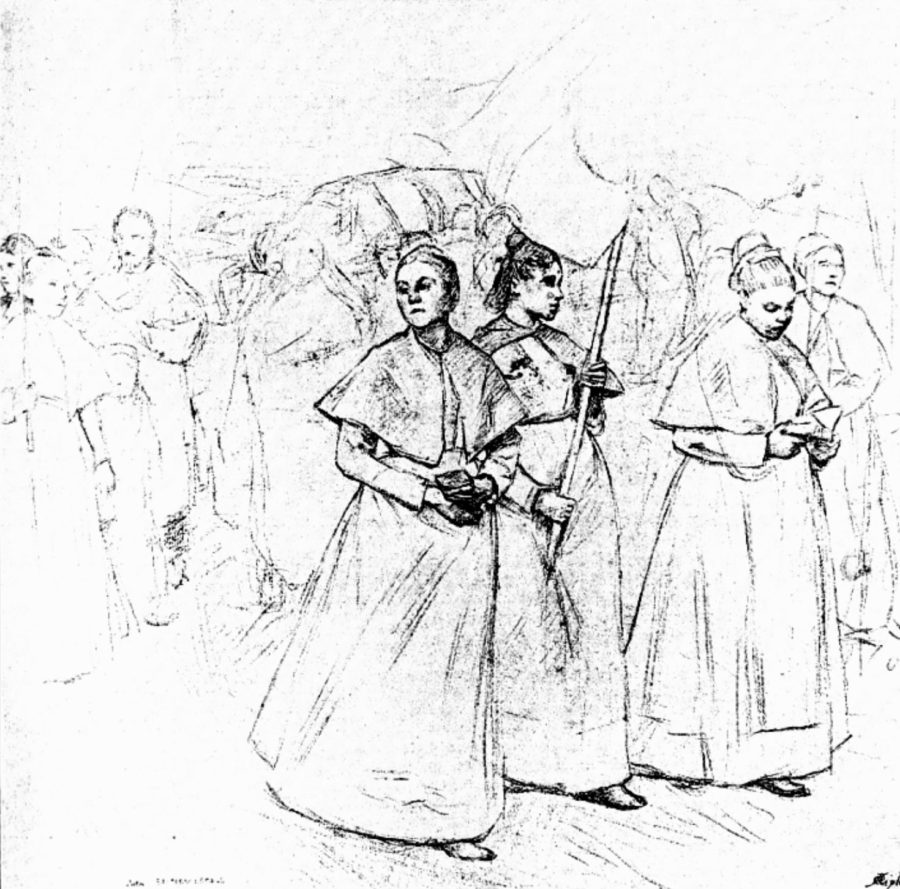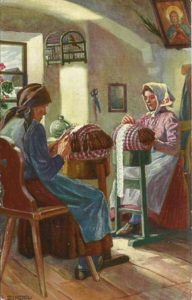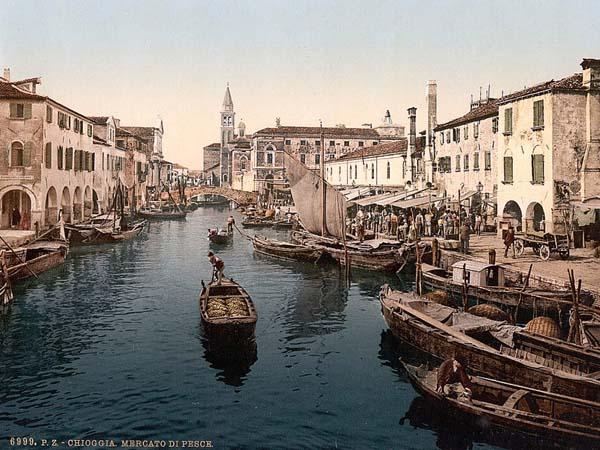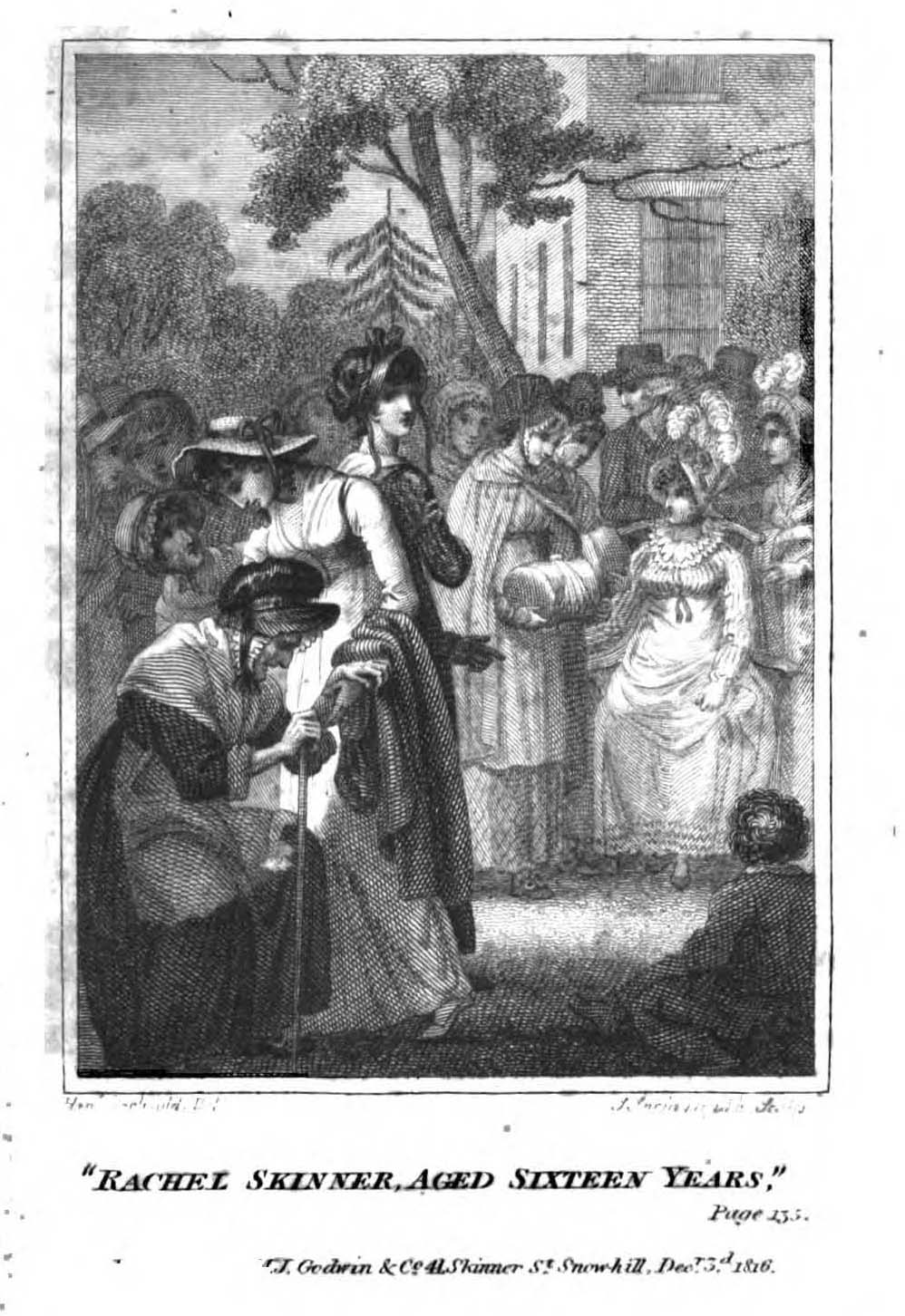
Joanna Desideria Courtmans-Berchmans, by Jules van Biesbroeck, Letterenhuis Antwerp
For Johanna-Desideria (Désirée) Berchmans (1811-1890), often known by her married name Courtmans, the purpose of literature was to make a difference to society. The novel was moralisation and enlightenment by other means. (Louise Otto-Peters, whom we looked at in a previous post, took a similar approach but it was even more prevalent in Belgium due to the absence of a substantial educated public for literature in Flemish.) There were other women writers connected to the Flemish Movement, such as Marie Doolaeghe,[1] but Courtmans-Berchmans was probably the most important female author active in the Flemish literary revival of the mid-nineteenth century. Although she only turned to prose in her 40s, she became a prolific novelist, producing a book every year and sometimes more. As her father was a teacher, her husband was a teacher, her daughters were teachers, and she herself attempted to run a boarding school in Maldegem, it is perhaps not surprising that schools feature regularly in her novels. But education was not just her theme, it was her mission. Schooling, and particularly girls’ schooling, was a political battleground in nineteenth-century Belgium, and both in her life and her fiction Courtmans-Berchmans was a combatant. Her novel De hut van tante Klara (1864) was an indictment of the lace schools: her title – with its deliberate echo of Harriet Beecher Stowe’s Uncle Tom’s Cabin (1852) – implied that children’s lacemaking was a form of slavery.[2]
As discussed in our previous blog about Father Constant Duvillers and the lace-school in Middelburg, the 1840s were the ‘Hunger Years’ in Flanders, a situation brought on by overlapping crises in the linen industry and in agriculture. Famine was only averted by the coordinated action of local elites, particularly the Catholic Church and landowners, with the aid of the Belgian state. They sponsored lace-schools, which provided an alternative source of income to a population which had previously been dependent on flax-spinning. However, this was not a purely charitable endeavour; lace-schools, even those that received philanthropic support or subventions from the local authorities, needed to make money to remain open. A few provided some hours of basic teaching in the three Rs, but most were more workshops than schools, and the persons in charge – usually members of religious orders but sometimes private individuals – were also intermediaries in the lace trade, bound up in a network of commercial relationships. In consequence, the schools were regularly denounced for economically exploiting their young charges, while damaging their bodies and minds in the process. The Roeselare Chamber of Commerce, for example, used its annual report for the year 1864 to the Belgian Government to condemn the lace-schools: ‘The false mask of devotion to the working class fails to hide what is in most cases the spirit of avarice, pushed to its most extreme limits and which sacrifices the health, the education and the future of these poor slaves, wretchedly deceived and abused, to this greed.’ The American Civil War was still being fought in 1864 so the use of the term ‘slaves’ was deliberate. 1864 was also the year that Berchmans-Courtmans published her novel De hut van tante Klara.
How did she become involved with lace? To answer this we need to go back a little in her biography. Her father had been mayor of the village of Mespelare near Dendermonde in East Flanders (he was the model for the hero of her eponymous novel De burgemeester van 1819 [1861]). At the age of nine she was sent to a boarding-school in the French speaking part of Belgium; at the time a good education for a woman meant first and foremost learning French. In 1835 we find her lodging in Ghent with Coleta Tanghe, a lacemaker and dealer. (In her letters Berchmans referred to her as ‘Aunt Colette’, but the precise family relationship is unclear.) Also lodging in the same house was the young teacher Jan-Baptist Courtmans (1811-1856), and in very short order the pair fell in love, married and started a family, all while living with ‘Aunt Colette’, as they would for most of the next decade. Courtmans was secretary of the Maetschappij van Vlaemsche Letteroefening [The Society for Flemish Literature], which united many of the leading writers in the nascent Flemish movement such as Jan Frans Willems, Prudens Van Duyse and Ferdinand Augustijn Snellaert. The Courtmans family played host to visiting German writers such as the folklorist Johann Wilhelm Wolf, and Désirée narrated some of the folktales that made up his Niederländische Sagen (1843).[3] She was also launching her own writing career. As with almost all Flemish authors in the wake of Henrik Conscience’s De Leeuw van Vlaenderen (1838), her first poems drew on Flanders’ romantic, medieval past, although she particularly highlighted the contribution of women, especially queens, to the cause of national independence.
In 1843 the Courtmans moved to Lier when her husband took a position as professor of Flemish at the Teacher Training College. For the next decade, as the family continued to grow, her literary output shrank, but when Jan-Baptist became too ill to work (he would die in 1856), she took up her pen again, in part to earn money. After her husband’s death, and with eight children in tow ranging in age from three to nineteen, she moved to the small town of Maldegem. Why she chose this location is a bit obscure, but she had a definite plan: she would open a girls’ boarding-school with herself and her elder daughter as teachers. She placed adverts in the local newspapers. The house she chose was on Noordstraat, directly opposite the lace-school run by Father Vinckier, Maldegem’s priest from 1832 to 1872. The two quickly, indeed almost immediately, became bitter opponents. Noordstraat Maldegem was one of many small-town front lines in the culture wars between clericals and liberals that divided Belgium politically.[4] Courtmans-Berchmans considered herself a good Catholic, but she was a liberal in political matters.

Noordstraat Maldegem, c. 1909. Fifty years earlier this was a frontline in the Belgian ‘culture wars’
Like Duvillers in Middelburg, which was only a walk away, Vinckier intended to dominate his parish, and the lace-school was one of the means to achieve this end. It had been founded as a private initiative in 1842 but was taken over by Vinckier in 1845 or 1846. (Perhaps he had been inspired to do so after paying a call on Duvillers’ school: visiting priests were common characters in the latter’s songs.) In the mid 1850s more than 300 girls, the bulk of the available juvenile, female population, attended.
More than one story is told about Vinckier’s first encounter with Courtmans-Berchmans, but the gist of them all is he told her that Maldegem had no need of educated women and so she had better set up shop elsewhere. Her reply was ‘ik blijf’ [I’m staying]. However, she lost the first battle in her personal ‘culture war’ when her boarding-school was wound up in 1858 due to, as she explained to the local council, ‘malicious obstruction’. As it was around this time that she started seriously writing again, the cause of literature gained by the failure of her boarding-school ambitions. But in 1857 a new front opened up. Municipal provision of some sort of primary schooling had become law in 1842, but in the 1850s the Liberal government began to put pressure on councils to build separate schools for girls. Unlike the lace-schools these would not be places of work but would teach reading, writing and other skills. They would be free to those unable to pay, which was the majority of the population in Maldegem. The ecclesiastical authorities were worried that these public schools would compete with the lace-schools, and thus draw the female population away from their control. One solution was, therefore, to convert the lace-schools into public schools by introducing a few extra lessons in reading and writing. This was the strategy suggested by the Archbishop of Bruges and initially followed by Vinckier. He proposed that Sophie Westerlinck, the mistress of his lace-school, should be appointed Maldegem’s first teacher of the girls’ public school, which would succeed the lace-school. However, Courtmans-Berchmans was simultaneously lobbying hard to ensure that her daughter Mathilde got the post. After much dithering by the council, she gained the cause, and Mathilde Courtmans was appointed on 3 February 1858. Several of her sisters would join her as teachers in due course.
Yet this was not the end of the struggle. Education was provided, but parents were not obliged to take it up. Through the 1860s and 70s the lace-schools, both Vinckier’s and other establishments in Maldegem, continued to attract more pupils than the public school. Girls in the lace schools earned money which helped support their families, and in ‘Poor Flanders’ this support could be vital to a family’s survival. But the Church had other ways of exerting control. In 1879 a new Liberal government attempted to laicise primary education in Belgium but the Church hierarchy fought back, threatening to excommunicate all teachers and all parents of pupils attending state primary schools. In rural Catholic Flanders the effect of the first ‘School War’ (Schoolstrijd) from 1879 to 1884 was to empty the state primary schools and thus put the Courtmans sisters out of work.
However, this defeat lay some years off. During the 1860s Courtmans-Berchmans was battling for decent schooling for Flemish girls on several fronts: with the local council (to whom she complained about the condition of the school buildings, and especially the playground, as she was convinced of the need for physical activity and fun as part of a rounded education), in the local papers such as De Eecloonaer where she berated her fellow citizens for their parish pump politicking, and in her novels, such as De hut van tante Klara. No works by Courtmans-Berchmans are available in English (to our knowledge) but sections of this novel were translated by Brenda Mudde, and commentated on by Lia Van Gemert, in the latter’s collection Women’s Writing from the Low Countries, 1200-1875: A Bilingual Anthology (Amsterdam University Press, 2010).
The eponymous heroine, Klara Roman, is a herb-gatherer and the widow of a supposed ‘jacobijn’ barber-surgeon (Jacobin was a term of abuse aimed at anyone with liberal or anticlerical ideas). Living with her are two orphaned granddaughters, Mieke and Roza, or Mieken and Rozeken as they usually appear in the text (along with their father, an unimportant character). An industrial accident will soon rob her of her other son-in-law, and her other daughter with her tiny children will also take up residence in her crowded cottage. At first, though, all seems idyllic, the six-year-old Mieken and Rozeken playing in the healthy outdoors while Klara picks her herbs for the apothecary. Yet there is a presentiment of tragedy: the girls weave crowns of flowers that make them resemble two virgin martyrs. Into the scene walk the agents of misfortune, the sisters Ludgarda and Rosanna Devroede, offspring of a disgraced notary. They have come to persuade the local landowner, Mevrouw Van Dooren, to set up a lace-school which they will run. Van Dooren wants to help a population suffering through the linen crisis. But she is also an enlightened philanthropist, so the rules she lays out for her lace-school specify that children under nine should only work for three hours a day on lace, that there should be lessons in other subjects, plenty of play-time, and that the children themselves should receive the profit from their work. This is not at all to the Devroede sisters’ liking, but they accept the position, and soon the old village spinning house is converted into a lace-school.
The school is not an immediate hit. The poorer inhabitants want their daughters to start earning, three hours work is not enough. The village notables object to the common people learning to read. The most influential man in the village, Mr Hardies visits Mrs Van Dooren to warn her:
You are undermining the pillars of society. You drive the insignificant upwards in order to bring down the great. You wish to give the vermin wings so that they may rise up with the eagle, and you don’t even seem to understand that one swipe of its claws can crush thousands of these insects… Artificial reading will grow into exercises to develop the mind, and then what – what will become of society once we get that far? Oh, Madam, I am saddened, saddened to the soul when I think of it.[5]
Although not a priest, fat Mr Hardies with his sanctimonious shows of piety, is a thinly disguised portrayal of father Vinckier. Mrs Van Dooren, fortunately, is equal to this pressure. For three further years (we are now in the late 1840s), until they are nine, Mieken and Rozeken continue at the school with Klara’s blessing. They learn, they earn and they remain healthy. But then their benefactor dies, and a new regime is established in the lace school. All the poor girls in the parish are obliged to go, or their families will cease to receive charity: within a month there are 400 girls in the school. All other classes are stopped, as is playtime. The children are charged for the thread and other equipment, which had previously been a cost of the establishment. According to Aunt Klara the luckiest are those who die young, but those that survive this ‘kinderslavernij’ [child slavery] will become feeble housewives, with their twisted hands.
The fate of her two grandchildren under this new order is very different. Mieken is constantly punished with the ‘zottekap’ [dunce’s cap] and the ‘lange tong’ [a wooden board hung on a pupil’s back as a mark of shame] for not fulfilling her lace quota, she is beaten with rods and made to sit near the door, far from the warming fire; soon she is coughing and fading. Rozeken, however, with her ‘downcast eye’ [a regular sign of hypocritical submission and devotion in the literature of lacemaking] adapts to the Devroedes’ bigotry and greed, and so is rapidly promoted. She transfers designs onto the parchments used by the pupils, particularly the ‘Brusselsche bloemen’ [Brussels flowers, or Duchesse lace], a specialist job.
Meanwhile Hardies has forced the Devroedes to accept his ‘protection’ and has become a silent partner in the school. The miser estimates that each girl earns at least fifteen centimes profit a day: 600 or more girls equals 100 francs a day, divided equally between Hardies and the Devroedes. The three plot to dispatch Rozeken to the convent at Zwijbeke, in order to improve their relationship with this important intermediary in the lace trade.
The other girls are becoming pale, thin, pinched and ill. In fact they are dying of consumption (and this mirrors the reality: between 1852 and 1856 twelve pupils in the Vinckier lace-school died of consumption, and two others of typhus: the mayor of Maldegem wrote in 1857 that ‘the cause of death of the lace apprentices is a wasting disease to which the parents have given the vigorous name “schoolsickness”’). Their ill-health becomes very obvious on the feast of the Assumption of the Virgin Mary, 15 August, when the school parades through the town.
They were headed by the two school mistresses in their black silk dresses, lace-edged coats, and pretty, white silk hats decorated with purple violets. Each had a fat gold chain with a precious watch around her neck, and there was nothing to find fault with in their beautiful attire. Then came the pupils.
A sigh of pity escaped each breast on seeing these pale creatures, these stunted limbs, these thin bodies, which seemed to be fighting a stubborn battle of life and death.
Never had poverty made a more painful impression than it did now that so much trouble had been taken to adorn it.
The school’s older pupils looked very neat in cotton dresses, and it was evident that their parents had done the impossible to fulfil the needs of their money-earning daughters. Among these children, the granddaughters of Aunt Clara were to be found.
They were followed by the smaller children…. Hundreds of clogged little feet came clattering by. Some few were in new clogs, but many wore old ones, dripping with water and sand, and the clunking, rattling and clattering of the clogs mingled with the monotonous church hymns in such an unpleasant way that it saddened all attentive viewers.
[…]
Shamelessness had never shown itself more plainly than on that procession day. Those who, by forcing them to labour well beyond their years and strength, had transformed blooming children into creatures whose weakness would be passed on to the next generation, and had turned golden youths into pale flowers bending towards the grave even in the morning of life, they were not shamed to put the misery of these child-slaves on show as a foil to their own wealth. They braved the looks of the crowd, which seemed to call out to them:
‘Your pomp, your wealth, is the fruit of your slaves’ labour. It is the purchase price of the victims you drag to an early grave.’
‘Lost souls! Are you not afraid that He, who is the strength of the weak and the ealth of the poor, will one day call you to account for the fate of those unhappy creatures whose bodies and souls were entrusted to you? You have prematurely killed their spirits, and their bodies you have tortured, so that they will never regain the strength to rekindle their extinguished spirits. No, you are not afraid, for you recognise no other virtue for the people than ignorance, as it is ignorance on which you have built the throne of your rule.’[6]
Mieken is one of the fatalities. Although she rallies for a while, long enough to start a romance with her neighbour Paulus, her funeral will also be her wedding. Her father, long since too ill to work, soon follows her to the grave. Although Rozeken’s wages would now really help Aunt Klara’s household, she follows the plan laid out by her employers and joins the convent as a novice. Aunt Klara’s other two grandchildren are now also in the lace school and one is already showing signs of the wasting sickness. At last Aunt Klara, who perhaps understandably is given to weeping, now turns defiant: she removes her grandchildren, even though this means the family cannot receive poor relief from the council, which is under the thumb of Hardies.

Georges Laugée (1853-1937), Enterrement d’une jeune fille à Étricourt. Musée de l’Échevinage, Saintes. This is an example of ‘the wedding of the dead’.
But times have changed. The Crimean War knocks the bottom out of the handmade lace market; the wages of the lace mistress employed by the Devroedes is halved, and even the sisters themselves cut back on their consumption of eau-de-cologne. Punishments increase in an attempt to squeeze more work out of the children, but still wages decline. For the men a new opportunity has opened up as migrant harvesters in France, so the poorer villagers are not so dependent on the lace-school. Other women start to follow Aunt Klara’s example and remove their daughters. The partners in the venture have started to bicker when Hardies drops down dead of a heart attack; he returns like Jacob Marley as a ghost, weighed down with account books and banknotes. The sisters’ father is released from prison and with him they slip away into the night. The lace-school building is put up for sale. Aunt Klara has one last task to fulfil: she goes to the convent to persuade Roza to renounce her noviciate and come back home.
In her introduction Berchmans-Courtmans made explicit that this novel had a social purpose, to expose the exploitation of young girls in the lace-schools, because such institutions ‘disgraced a civilized country’. She was not against the idea that girls engaged in some work that could contribute to the household income, but that they should also receive an education that expanded their mental horizons, that they be taught useful lessons in tasks that would help them later as housewives (sewing, knitting), and that their bodies be allowed to bloom in exercise and fresh air. The campaign against the lace-schools would grow, picking up themes rehearsed by Berchmans-Courtmans, such as the impact on the reproductive potential of the Flemish population. In 1876 the sociologist Guillaume de Greef launched a newspaper diatribe against the lace-schools run by religious orders and not just because they exploited their charges and condemned to poverty, ill-health and early death, but also because they sapped the intellectual and moral strength of the female population: ‘they are not even slaves, because slaves can rise up, but not they’.[7] However, during the ‘School War’ clerical Flanders rallied to the defence of the lace-schools, which survived well into the twentieth century. Thus they remained a theme for later Flemish writers such as Virginie Loveling (in Sophie 1885, where the Darwinian implications of a stunted female population are brought to the fore) and Reimond Stijns (in Hard Labeur 1904). Of course the fate of the ‘hard worked, half-stifled little girls’ in the lace schools was not just a campaigning matter for Flemish writers, as we have already seen in the case of Charlotte Yonge’s The Clever Woman of the Family, published the year after De Hut van Tante Klara.

Jules Bastien-Lepage, Funeral of a Young Woman at Damvillers, c. 1880.
[1] Doolaeghe (1803-1884), to whom we may return, wrote an encomium for ‘my noble friend’ Courtmans-Berchmans in 1883, in which she praised her efforts to ‘enlighten the people through her writing’ [Het volk verlichtend door zijn woord]: ‘Hulde aan mijne hooggeachte vriendin Mevr. Courtmans, geboren Berchmans’, De Vlaamsche Kunstbode 13 (1883): 261-2.
[2] There are several biographies and other studies of Courtmans-Berchmans: I have drawn mostly on Hugo Notteboom, Rik Van de Rosteyne and Michiel de Bruyne (eds) Over Mevrouw Courtmans Leven en Werk (Maldegem: Mevrouw Courtmanscomité, 1990); and Jules Pée, Mevrouw Courtmans, een letterkundige studie, (Antwerp: Ruquoy, Delagarde, Van Uffelen, 1933).
[3] Johann Wilhelm Wolf, Niederländische Sagen (Leipzig: F.A. Brockhaus, 1843), p. xxi. German philologists such as Wolf played an important part in the Flemish revival.
[4] For the ‘culture wars’ in Belgium, see Els Witte, ‘The Battle for Monasteries, Cemeteries and Schools: Belgium’, in Christopher Clark and Wolfram Kaiser (eds), Culture Wars: Secular-Catholic Conflict in Nineteenth-Century Europe (Cambridge: Cambridge University Press, 2003).
[5] Lia Van Gemert (ed.), Brenda Mudde (trans.) Women’s Writing from the Low Countries, 1200-1875: A Bilingual Anthology (Amsterdam, 2010), pp. 523-4.
[6] Van Gemert (ed.), Mudde (trans.) Women’s Writing from the Low Countries, pp. 525-6
[7] Guillaume Degreef, L’ouvrière dentellière en Belgique (Brussels, 1886), p. 8. The 1886 volume is a new edition of his newspaper articles.
